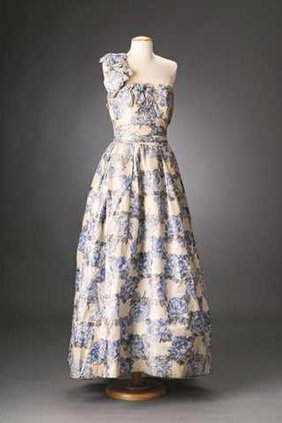Mid-Century Modern
When: Through Jan. 25; panel discussion, 6:30 p.m. Nov. 20
Where: John S. Burd Center for the Performing Arts, Leo Castelli Gallery, Brenau University, 429 Academy St., Gainesville
How much: Free
More info: 770-534-6263 or cwohlander@brenau.edu
Remember June Cleaver sauntering around in a dress and pearls, cleaning the Cleaver house on "Leave it to Beaver"?
As silly as it seems to us now, it wasn’t far from the reality of the 1950s.
"Mid-Century Modern," an exhibit opening Tuesday at Brenau University’s Leo Castelli Gallery, focuses on women’s clothing in the 1950s and how it related to the social environment of that era.
"The thrust of the exhibit basically is trying to show how, in the 1950s, art and design were sort of moving forward, and there was a lot of technological advances and lots of things were going forward after World War II. But women’s clothing was really looking back," said Lori Gann-Smith, the curator for the exhibit.
Although women had been a large part of the work force as their husbands fought in World War II, Gann-Smith said the clothing of the time showed how, when the war was over, women were urged to step back into more "traditional roles."
"There was a real sort of retro feel and looking back to even the turn of the century for the silhouettes and things like that, and what we’re trying to do is sort of draw a parallel between what was going on with women’s clothing and what was going on with women’s roles in society," Gann-Smith said.
"In other words, they were being asked to sort of step back into so-called traditional roles that they had before the war, even though during the war years they were in the work force."
Gann-Smith said the exhibit displays every article of women’s clothing, from underwear to accessories. "We’ve got some girdles and underwear to show the understructure of how women were being asked to conform to these sort of standards of beauty or ideals of beauty," she said.
"We even have a small collection — and these were actually from my personal collection — of aprons from that time, and they’re just fantastic, you know, these things all the way from very utilitarian to very sort of ornamental hostess aprons."
Gann-Smith said one particular dress stands out to her as an example of that era’s style. "I think that the evening gowns really sort of epitomize that glamour that we all associate with the 1950s, that sort of really put-together look," she said.
"We have one cocktail dress; it’s an evening dress, a short length, black, strapless, really beautiful and has gorgeous beading detail around the waist. Nobody can look at that dress and not think of the ’50s because it’s such a sort of iconic silhouette and piece from that time."
Gann-Smith said the clothes will be accompanied by facts about life and politics in the 1950s, and clips of TV shows including "Leave it to Beaver" and "Father Knows Best".
"Even though the clothing is beautiful, it is sort of masking this sort of fairy-tale existence that is also being reinforced by the media," she said.
Gann-Smith said the clothes are part of "a pretty extensive historic clothing collection" owned by Brenau.
"Mid-Century Modern" includes clothing donated by Bette Todd Wages, who gave much of the clothing in the Brenau collection because "she was afraid that this sort of handwork was a dying art."
Also included in the exhibit are high-end couture pieces from Princess Lucie Shirazi, who was married to one of the sons of the shah of Iran and was known for her philanthropic work as one of the founders of the World Wildlife Fund.
"I think that Brenau acquired her collection and some of the other collections that we’ve acquired because they are a great resource for our fashion students and even our costume students and our art students, to be able to come in and look at some of these pieces and see how they were constructed and see the actual silhouettes," Gann-Smith said.

